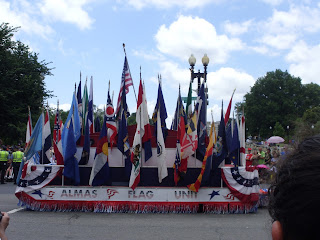"America's Birthday", complete with a special edition "flavor" in Baskin Robbin's ice cream parlour. Being British and observing the 4th of July is a strange experience in itself, but it seems especially ironic as a history student. However, I still found the events of the day extremely entertaining, and even more enlightening for being an "outside" observer on the scene. We decided to watch the Independence Day parade along Independence Avenue, close to the Washington Monument. Shops were closed, street sellers had set up to sell American merchandise, ice cream, hot dogs, and other fast food. Roads were closed, Metro stations full, and there was a general carnival atmosphere around the Capitol.
There was a heavy military element to the parade, with all parts of the Armed forces represented. I would say the soldiers and other army personnel attracted the loudest applause, and once again I was reminded that this nation's identity comes very much from their historic debt to their troops, who helped to win independence.
There were also colourful floats like these, someone said that they were supposed to represent each state, and I think this was somewhere rural, maybe Kansas, if had a lot of balloons on it and then some fields.
The American Eagle
One of many marching bands. Each "College" here has it's own colours and marching band, especially to perform at sports matches, which are taken at least as seriously as academia, and in some places more seriously. I think this is one of the biggest contrasts between U.S and U.K tertiary education.
More interesting floats. The people holding up the giant Tweety bird balloon had a routine in which they ran in a circle to spin the balloon, whilst keeping the strings untangled.
At first I thought that this was just another case of flag overload. Actually each flag on the float is one of the individual state's own flags, carried together with the flag of the United States on top. I don't think I knew that each state had its own flag, although the Italian states etc. have their own flag, so I probably just didn't think of it.
The stars & stripes are a central part of the parade. Strange, in Britain, although the flag is seen at events, e.g. Diamond Jubilee (some Americans don't know what the word "Jubilee" means, I guess that should have been obvious, but I found it an amusing concept to explain to them, that people should celebrate being ruled over by a monarchy) or the Olympics, it would never be a central focus of celebrations. Apparently (if my American housemates are being serious) it is illegal to leave the flag out in the rain, or to set it on fire, or to leave it on the ground for more than 3 days.









No comments:
Post a Comment